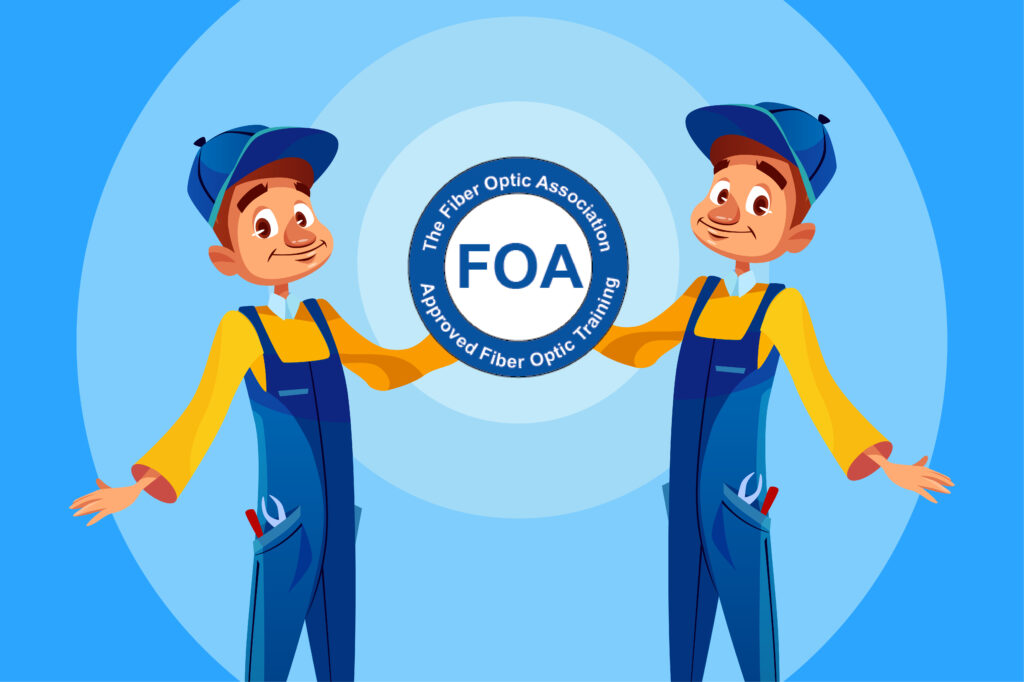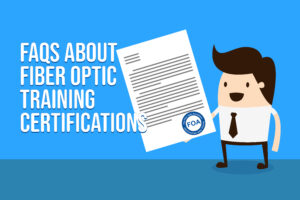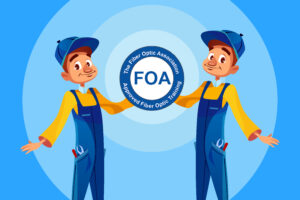In a time where almost everyone needs the internet, it became evident how fiber optics play a significant role in the infrastructure that runs the world’s connectivity. With its capacity to deliver the fastest mode of transmission for information and telecommunications, optical fiber gradually gained its popularity in the business world.
It is without a doubt that the demand for fiber optics across organizations increased over the past few years. For this reason, the need for fiber optic technicians grew as well. With this blog, you’ll be able to set your expectations on what’s waiting for you in Fiber Optic Association (FOA) training programs.
Finding the Right Job in the Field of Fiber Optics

As you can see, fiber optic technicians are critical to the execution of broadband communications operations. With their assistance, organizations are able to empower their business sites with the capabilities of fiber optics. The installation of fiber optic cables enables the transmission of digital information over long distances. Hence, it is essential for businesses to hire certified fiber optic technicians for this job.
There are certain pieces of training technicians need to undergo in order for them to become professional fiber optic technicians. Aside from that, they also need the skills and resilience necessary to work in tight spaces, use ladders, and handle heavy tools. If you want to acquire all the stipulated prerequisites to become an accredited fiber optic technician, it is crucial that you avail of the training programs needed for the FOA certification.
Benefits of an FOA Certification
Just like any certification program, the people who pass the certification tests achieve a certain level of competence in the field of fiber optics. Once you acquire your FOA certification, you will be recognized by business owners as professional fiber optic technicians. Moreover, they will be able to see you as competent fiber optic personnel with the knowledge and expertise necessary in the field.
Because of these benefits, many companies nowadays require their technicians to acquire FOA certifications. There are also some that offer these certifications to their personnel by providing internal training classes.
Getting to Know the Certified Fiber Optic Technician (CFOT) Certification
The certified fiber optic technician FOA certification is primarily intended for all fiber optic technicians. Through this training program, they are able to hone their knowledge, skills, and abilities that are applicable in the installation and operation of fiber optics. In most cases, CFOTs work in the industry as fiber optic installers or contractors. There are also some that are involved in the manufacturing of fiber optic components like cables, patch cords, and other fiber optic technologies. Although this is true, CFOT certification is also a credential expected from optical fiber consultants, network designers, trainers, and estimators.
What You Should Expect in CFOT Certification Training Programs
If you’re eyeing to get your certification from CFOT training programs, it’s ideal that you have an overview of the topics it will cover. By doing that, you will be able to prepare for the challenges that will come your way as you go through this fiber optic course.
Here are some of the common topics you are likely to encounter in this training program:
- A run-through of the prevalent fiber optic applications and installations worldwide.
- The communication systems that make use of fiber optics.
- The fiber optic components that are appropriate for fiber optic networks.
- The installation of on-premise and off-premise fiber optic cables.
- Introduction of splicing and termination.
- How to test fiber optic components and cable plants.
- Hands-on lab exercises (hands-on fiber optic splicing, termination, and testing)
Typical Field Experience to Qualify for Direct CFOT Certification (Work to Cert)
If you want to qualify for a direct CFOT certification, it is required that you have at least two years of relevant field experience. With that said, it’s necessary to have a documented experience in installing and testing fiber optic networks in order to avail of this type of certification. Furthermore, the training acquired through employers, manufacturers, and vendors of cabling products can also be recognized as one of the experience requirements.
To discuss further regarding this matter, here are some of the field experience in installing and testing fiber optic networks that should be included:
- Participation in multiple installation jobs. According to experts, it is recommended that technicians include their experience in premises and OSP installations.
- Preparation of various cable types.
- Fusion splicing and several termination types.
- Visual inspection and testing of Visual Fault Locator (VFL), Optical Loss Test Set (OLTS), and Optical Time-Domain Reflectometer (OTDR)
Getting to Know the Certified Premises Cabling Technicians (CPCT) Certification
The CPCT FOA certification is usually applied by premises cabling network designers, installers and operators. Aside from that, it can also give the IT or security personnel that are responsible for network operations the training they need to get their job done. To give you an overview, premises cabling refers to the customer-owned cabling found in buildings and campuses. In addition to that, the knowledge, skills, and abilities honed by this certification cover copper wire cabling, fiber optic cabling, and wireless communications.
Generally, premises cabling systems are often utilized for computer Local Area Networks (LANs), CCTV and alarm security systems, distributed antenna systems for cellular and Wi-Fi. Furthermore, it is also used for building management systems and other applications inside buildings or campuses. By availing of a CPCT course, you will be able to hone the necessary skills to work with premises cabling through hands-on lab activities.
What You Should Expect in CPCT Certification Training Programs
Just like the CFOT certification, it is also necessary for you to undergo a training program in order for you to qualify for the CPCT certification. To help you finish your CPCT course more efficiently, it’s important that you have a background of the topics the training program will cover.
Here’s a list of topics that you should expect in CPCT certification training programs:
- An overview of the copper, fiber, and wireless premises cabling systems.
- The communication systems that are using premises cabling.
- The standards of premises cabling.
- Unshielded Twisted Pair (UTP) and coax copper cabling.
- Fiber optic cabling.
- Wireless cabling.
- How to create the right premises cabling network design for a building.
- Premises cabling installation.
- Testing of copper and fiber cable plants.
- Hands-on preparation, termination, and testing lab exercises.
Typical Field Experience to Qualify for Direct CPCT Certification (Work to Cert)
In order to be eligible for the direct CPCT certification, you need at least two years of relevant field experience. This includes a documented experience of installing and testing premises cabling networks. The same way that training by cabling product employers, manufacturers and vendors can be recognized as part of the experience requirements in CFOT certifications, it can also be acknowledged in CPCT FOA certifications.
In addition to that, here’s a list of the field experience you can include when you apply for this direct certification:
- Multiple participation in installation jobs. It’s a plus if you have participated in building and campus installations.
- Installation of different types of cables and hardware.
- Termination of UTP, coax cables, and fiber optic cables.
- Copper and fiber cable testing.
- Experience in handling fiber optic tools and test equipment.
How Fiber Optic Technology Makes an Impact in Our Daily Lives

Over the years, it has been renowned what the thin glass strands in fiber optics can do for business organizations. One of the things that made it popular across industries is its ability to deliver fast internet connection. Apart from that, it has also been seen how fiber optics displayed its versatility as it was used by organizations in broadcasting and computer networking.
In the present time, it is undeniable how the number of fiber optic users increased in the business world. Different industries such as the medical and military industry have made the most of its capabilities to optimize their operations. That’s why it’s definitely a great idea to take a career path in fiber optics today.
Structuring Your Resume for a Career in Fiber Optics
Clearly, creating a good resume is vital in order for you to land a good job in the field of fiber optics. You can do this easily by structuring your resume according to the qualifications necessary to get into the industry you want to apply to. Furthermore, it’s also important to note to create a good resume introduction.
Most often than not, the first thing employers see in your resume serves as their first impression of you as an applicant. Hence, it’s ideal that you focus on your strongest experiences and abilities when you create your resume. If you take the time to highlight the skillsets you can use to contribute to the success of your employer’s company, it’s likely that they will see you as a viable candidate for the job.
If you want to raise your qualifications in the field of fiber optics, make sure to avail of FOA training programs for certification. At present, there are plenty of organizations that can help you get the appropriate training you need to be competent in the field—Nexus-net is one of them. Throughout the years, Nexus-net has produced a lot of competent fiber optic technicians. You can be one of them if you avail of their training programs.



